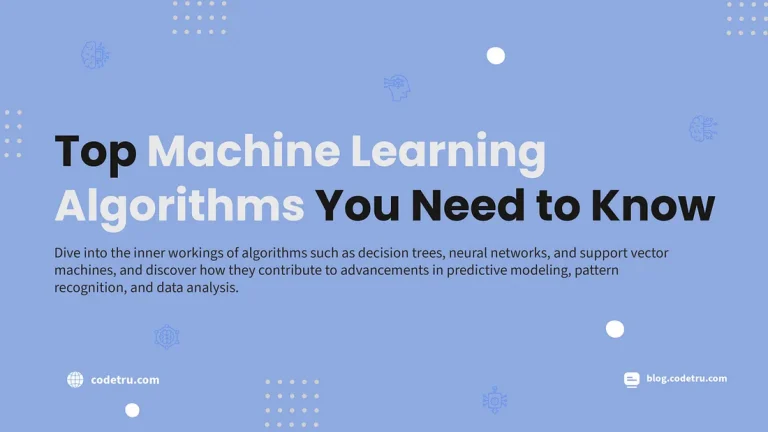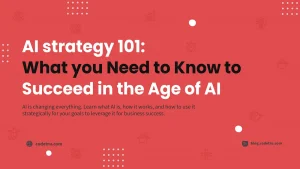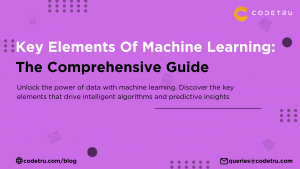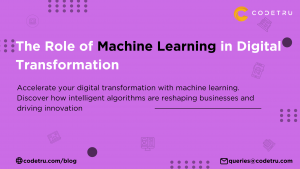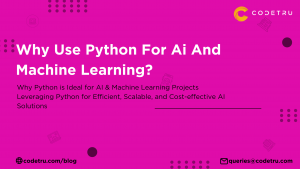Machine Learning is a term that might have caught your attention in past years. Although it not a new term but with the rapid advancements in technology, its ruling the tech world.
Machine Learning has become increasingly popular and influential in various domains, such as computer vision, natural language processing, recommender systems, self-driving cars, and more.
One of the key components of ML is the algorithm, which is a set of rules or instructions that tells the computer how to learn from the data and make predictions or decisions. There are many types of ML algorithms, each with its own strengths, weaknesses, and applications. In this blog post, we will introduce some of the most common and widely used ML algorithms.
Before we fully dive into the specifications of each algorithm, let us first review some of the core concepts that are essential for understanding ML.
These algorithms are usually divided into three broad categories depending on how they learn from the data:
Supervised Learning, Unsupervised Learning, and Reinforcement Learning
Supervised learning
Here the algorithm learns from labeled data, which means that the data has some desired output or target value associated with it. It trains on the already existing data to predict the output. For example, if you want the algorithm to identify a flower, you will first have to provide it with pictures of different species of flowers along with their name and characteristics. It will then train on that data, by identifying which characteristics belong to which flower. Once the algorithm has been trained, it will use the existing input data to make predictions on unknown data. The goal of supervised learning is to find a function that maps the input data to the output labels, and then use this function to make predictions on new or unseen data. These models are widely used in marketing, healthcare, financial services
Unsupervised learning
In unsupervised learning, the algorithm learns from unlabeled data, which means that the data has no predefined output or target value. These models train on unlabeled data without any human intervention or supervision. For example, if we want to train an algorithm to cluster similar customers based on their purchase history, we do not need to provide any labels or categories for the customers. The goal of unsupervised learning is to discover hidden patterns, structures, or features in the data, and then use them to perform some tasks or gain some insights.
Reinforcement learning
The algorithm learns from its own actions and feedback, which means that the data is generated by the algorithm’s interaction with an environment. For example, if we want to train an algorithm to play a video game, we need to provide it with the game state (such as the position of the player, the enemies, the obstacles, etc.) and the reward (such as the score, the health, the level, etc.). The goal of reinforcement learning is to find a policy that maximizes the expected cumulative reward over time, and then use this policy to choose the best action in each state.
Evaluation Metrics
To measure the performance of ML algorithms, we need to use some evaluation metrics that quantify how well the algorithm can learn from the data and make predictions or decisions. There are many types of evaluation metrics, each with its own advantages, disadvantages, and assumptions. Depending on the task and the data, we may need to use different metrics or combine multiple metrics to get a comprehensive assessment of the algorithm.
Data Preprocessing
Data preprocessing is the process of transforming the raw data into a suitable format for ML algorithms. Data preprocessing is an important and often overlooked step in ML, as it can significantly affect the quality and efficiency of the algorithm.
Some of the Common Data Preprocessing Techniques
Data Cleaning: It improves the accuracy and reliability of the algorithm, reducing the noise and bias in the data.
Data Transformation: Improves the performance and stability of the algorithm, making the data more compatible with the algorithm’s assumptions or requirements.
Data Reduction: Increases the efficiency and scalability of the algorithm while reducing the overfitting and redundancy in the data.
Supervised Learning Algorithms
Some of the popular Supervised Learning Algorithms are:
Linear Regression
It models the relationship between one or more input variables (features) and a continuous output variable (target). The algorithm assumes that the output variable is a linear combination of the input variables, plus some random error. Linear regression can be used for regression tasks where the goal is to predict a numerical value, such as house price prediction or stock market forecasting.
The algorithm can be trained using various methods, such as ordinary least squares, gradient descent, or ridge regression.
Logistic Regression
A supervised learning algorithm that models the probability of a binary output variable (target) given one or more input variables (features). The algorithm assumes that the output variable follows a logistic function, which is a sigmoid-shaped curve that ranges from 0 to 1. The algorithm tries to find the optimal values of the coefficients (weights) that maximize the likelihood of the observed data. Logistic regression can be used for classification tasks where the goal is to predict a binary outcome, such as spam detection or fraud detection.
The algorithm can be trained using various methods, such as maximum likelihood estimation, gradient descent, or regularization.
Decision Trees
This algorithm constructs a tree-like structure of rules or conditions that split the data into homogeneous subsets based on the values of the input variables (features). The algorithm tries to find the optimal splits that maximize the purity or information gain of each subset. Decision trees can be used for both classification and regression tasks, where the goal is to predict a categorical or numerical value, respectively, based on the rules or conditions in the tree.
Each node represents a condition or rule that splits the data, each branch represents a possible outcome of the condition or rule, and each leaf represents a final prediction or value.
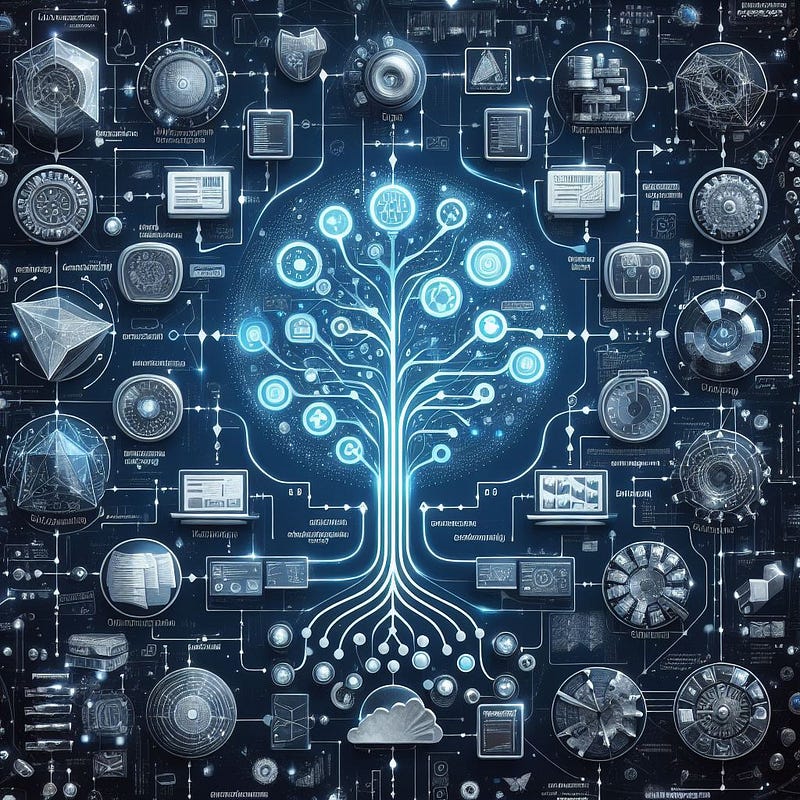
Random Forest
It is an algorithm that combines multiple decision trees into an ensemble, where each tree is trained on a random subset of the data and a random subset of the features. The algorithm tries to find the optimal number of trees and the optimal parameters for each tree that minimize the error or maximize the accuracy of the ensemble. This algorithm can be used for both classification and regression tasks, where the goal is to predict a categorical or numerical value, respectively, based on the majority vote or the average of the predictions from the individual trees.
Each tree is a decision tree that is trained on a bootstrap sample of the data and a random sample of the features, and the final prediction is the mode or the mean of the predictions from the individual trees.
Naive Bayes
It models the probability of a categorical output variable (target) given one or more input variables (features), based on the Bayes’ theorem and the assumption of conditional independence. The algorithm assumes that the output variable is dependent on the input variables, but the input variables are independent of each other given the output variable. The algorithm tries to find the optimal values of the parameters (probabilities) that maximize the posterior probability of the output variable given the input variables. Naive Bayes can be used for classification tasks where the goal is to predict a categorical outcome, such as text classification or sentiment analysis.
Unsupervised Learning Algorithms
Some of the most common and widely used unsupervised learning algorithms:
K-Means Clustering
It is an algorithm that partitions the data into k clusters, where each cluster is represented by its centroid or mean. The algorithm assumes that the data is continuous and can be measured by some distance metric, such as Euclidean distance or cosine similarity. The algorithm tries to find the optimal values of k and the centroids that minimize the sum of the squared distances between each data point and its closest centroid. K-means clustering can be used for clustering tasks where the goal is to group similar data points together, such as customer segmentation or image compression.
Each data point is assigned to the cluster with the nearest centroid, and each centroid is updated by the mean of the data points in its cluster.
Hierarchical Clustering
Hierarchical clustering is an unsupervised learning algorithm that builds a hierarchy of clusters, where each cluster is either a single data point or a combination of smaller clusters. The algorithm assumes that the data can be measured by some distance metric, such as Euclidean distance or cosine similarity. The algorithm tries to find the optimal hierarchy of clusters that reflects the similarity or dissimilarity of the data points. Hierarchical clustering can be used for clustering tasks where the goal is to group similar data points together, but also to reveal the structure or relationship of the data, such as gene expression analysis or social network analysis.
Anomaly Detection
Anomaly detection is an unsupervised learning algorithm that identifies the data points that deviate significantly from the normal or expected behavior of the data. The algorithm assumes that the data has some underlying distribution or pattern, and that the anomalies are rare or outliers. The algorithm tries to find the optimal threshold or boundary that separates the normal data points from the anomalous data points. It can be used for tasks where the goal is to detect or prevent abnormal or fraudulent activities, such as network intrusion detection, credit card fraud detection, or medical diagnosis.
Semi-supervised Learning Algorithms
Semi-supervised learning algorithms are the type of ML algorithms that learn from both labeled and unlabeled data, and then use the learned function to make predictions on new or unseen data. The algorithm assumes that the labeled data is scarce or expensive, but the unlabeled data is abundant or cheap, and that the unlabeled data can provide some useful information or guidance for the learning process. The algorithm tries to find the optimal function that leverages both the labeled and unlabeled data and improves the performance or generalization of the algorithm. Semi-supervised learning can be used for tasks where the goal is to predict a categorical or numerical value, but the available labeled data is insufficient or incomplete, such as text classification or image recognition.
The algorithm can be trained using various methods, such as self-training, multi-view training, co-training, or graph-based methods.
Reinforcement Learning Algorithms
Reinforcement learning algorithms are the type of ML algorithms that learn from their own actions and feedback, and then use the learned policy to choose the best action in each state. The algorithm assumes that the data is generated by the algorithm’s interaction with an environment, and that the feedback is given by a reward function that evaluates the quality of the action. It tries to find the optimal policy that maximizes the expected cumulative reward over time, and then use this policy to explore or exploit the environment. Reinforcement learning can be used for tasks where the goal is to control, optimize, or game play, but the optimal action is unknown or uncertain, such as self-driving cars, robotics, or chess.
Conclusion
Machine learning algorithms are powerful and versatile tools that can solve a wide range of problems and tasks, from simple to complex, from structured to unstructured.
As we conclude, it’s important to note that our exploration is just a glimpse into the world of Machine Learning algorithms. This field is always changing, with new ideas and solutions emerging regularly.
5 FAQs About Top Machine Learning Algorithms
1. What are supervised learning algorithms and how do they work?
Supervised learning programs can use labeled data to train models that can predict outcomes based on new, unseen information. These algorithms, such as linear regression and decision trees, are designed to learn to make accurate predictions or classifications from input-output pairs in training data e.g., logistic regression is used for binary classification tasks, while linear regression predict trends such as house prices .
2. How does unsupervised learning differ from supervised learning?
Unsupervised learning algorithms work with unlabeled data, and their goal is to discover hidden patterns or patterns without formal consequences. Unlike supervised learning, which relies on labeled data to guide learning, unsupervised learning methods such as K-means clustering and hierarchical clustering search data to group similar features or look for anomalies without a specific label or purpose
3. What is reinforcement learning, and where is it used?
Reinforcement learning algorithms learn by interacting with a situation, receiving feedback in the form of rewards or punishments. This type of learning is often used in self-driving cars and gaming AI to develop strategies that maximize accumulated rewards over time. For example, reinforcement learning might train an artist to play chess by optimizing it based on the outcome of the game.
4. What are some of the common methods of data preprocessing in machine learning?
Data preprocessing is essential for the quality and efficiency of ML algorithms. Key techniques include Data Cleaning to remove errors and inconsistencies, Data Transformation to normalize or bulk data, and Data Reduction to manage large datasets to eliminate redundancy. Thorough preprocessing ensures realize that algorithms work well and produce accurate results.
5. What is semi-supervised learning and how does it benefit machine learning?
Semi-supervised learning algorithms use both labeled and unlabeled data, improving model performance when labeled data are scarce or expensive. This approach combines the power of supervised and unsupervised learning to enable prediction. Methods such as self-training and graph-based methods can effectively use large amounts of unlabeled data to increase the accuracy of the model in tasks such as image recognition and text classification.

